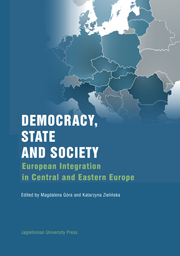Book contents
- Frontmatter
- Contents
- List of contributors
- Europeanisation in the EU New Member States. Aspects and Research Agendas
- Part one Democracy after Enlargement
- Part two Identity Transformations
- Part three Civil Society Organisations in Central and Eastern Europe
- Part four Europeanisation of International Relations
- The Changing Nature of Foreign Policy and International Relations in Central and Eastern Europe
- From Existential Politics Towards Normal Politics? The Baltic States in the Enlarged Europe
- Poland's Power and Influence in the European Union: The Case of Its Eastern Policy
- Visegrad Group Cooperation and “Europeanisation” of New EU Member States
- Index
Visegrad Group Cooperation and “Europeanisation” of New EU Member States
from Part four - Europeanisation of International Relations
Published online by Cambridge University Press: 05 September 2014
- Frontmatter
- Contents
- List of contributors
- Europeanisation in the EU New Member States. Aspects and Research Agendas
- Part one Democracy after Enlargement
- Part two Identity Transformations
- Part three Civil Society Organisations in Central and Eastern Europe
- Part four Europeanisation of International Relations
- The Changing Nature of Foreign Policy and International Relations in Central and Eastern Europe
- From Existential Politics Towards Normal Politics? The Baltic States in the Enlarged Europe
- Poland's Power and Influence in the European Union: The Case of Its Eastern Policy
- Visegrad Group Cooperation and “Europeanisation” of New EU Member States
- Index
Summary
Abstract: This article discusses the role of subregional cooperation in the expanded European Union (EU) with specific focus on the evolution of the Visegrad Group (VG) which is, in its own words, a central European subregional “alliance” which includes the Czech Republic, Hungary, Poland and Slovakia. Given that the VG's original purpose had been to support the EU (and NATO) membership endeavour, as EU entry approached there were doubts about whether it would have a meaningful role in the post-accession period. This article shows that far from fading into obscurity, the VG has established itself as a permanent and relevant part of the European political landscape and has made a successful transition from pre-accession to post-accession cooperation. In fact, the post-enlargement period seems to have given rise to the kind of substantial and rapidly growing political and practical cooperation agenda that had eluded the VG during the pre-accession period. As well as cooperation on EU affairs and a flourishing internal dimension of VG activity, some interesting new externally oriented agendas have also developed, including cooperation between the VG and other subregional groupings in and around the EU and with the Benelux Group in particular.
Introduction
Most of the subregional cooperation groupings that sprang into life in post-Cold War Europe had agendas linked to the EU membership aspirations of Central and East European states.
- Type
- Chapter
- Information
- Democracy, State and SocietyEuropean Integration in Central and Eastern Europe, pp. 293 - 310Publisher: Jagiellonian University PressPrint publication year: 2011



